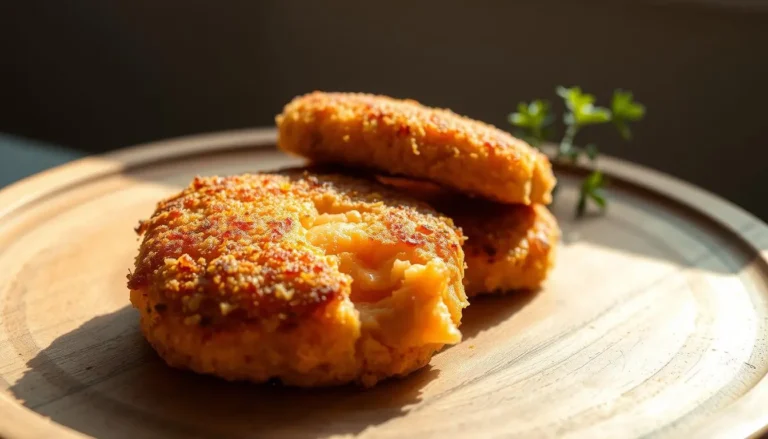Salmon Steak in the Oven: Easy Step-by-Step Guide
Dinner can be both elegant and easy. Imagine a salmon steak oven, shining with herbs, baked to perfection. It’s perfect for any meal, whether it’s a quick weeknight dinner or a special occasion.
With the right steps, you’ll create a dish that’s moist, flaky, and full of flavor. It’s a showstopper that impresses everyone.
This guide covers everything from picking the best salmon steak to getting the oven just right. No need to worry about overcooked fish. Just follow this foolproof plan for a meal that always impresses.
Table of Contents
Key Takeaways
- Salmon steak oven cooking ensures even heating and consistent results.
- Simple seasonings highlight the fish’s natural richness without complicated steps.
- Proper timing avoids overcooking, keeping the meat tender and juicy.
- Pairing with sides like vegetables or rice enhances the dish’s balance and nutrition.
- Mastering this method builds confidence for experimenting with flavors later.
Why Salmon Steaks Are Perfect for Oven Cooking
Salmon fish steak is more than just a meal. It’s a healthy and convenient choice. Their dense texture and rich nutrients make them great for oven baking. This method ensures every bite is tender and full of flavor.
Nutritional Benefits of Salmon
Salmon fish steak is a nutritional powerhouse. Each serving offers:
- Omega-3 fatty acids for heart health
- Lean protein to build muscles
- Vitamin D and B12 for immune and nerve health
Salmon Steaks vs. Fillets
Salmon steaks are cut across the backbone, making them thick and even. This shape absorbs heat well. Fillets, cut lengthwise, are thinner and harder to cook evenly. Steaks stay moist and avoid overcooking.
Why the Oven Method Shines
Oven baking is unmatched for its control. It offers:
- Even heat for consistent cooking
- No need to constantly flip or check
- Less splatter than pan-searing
- Easy to adjust portions for any meal
Salmon fish steak is a kitchen favorite. The oven’s reliability pairs well with their hearty texture. This makes every dish a hit.
Essential Ingredients for Perfect Baked Salmon Steak
Choosing the right ingredients is key to making a great baked salmon steak. This guide helps you pick quality parts that boost taste and texture. It’s all about simplicity.
Choosing the Right Salmon Steaks
Find salmon steaks with shiny skin and firm flesh. Wild-caught ones taste deeper, while farmed are easier to find. Make sure they smell like the ocean, not fishy or sour.
Choose steaks ¾ to 1 inch thick for even cooking.
Must-Have Seasonings and Herbs
- Salt and pepper: Balance natural oils and enhance umami.
- Lemon: Brightens the dish—use fresh juice or slices.
- Dill: Adds herbal freshness, especially with butter or oil.
- Garlic: Crushed or minced for aromatic depth.
Optional Flavor Enhancers
Make your baked salmon steak special with extras. Try capers for tanginess, Dijon mustard as a glaze, or honey for sweetness. Soy sauce adds umami, and white wine keeps it moist. Start simple and add more flavors later.
Preparing Your Salmon Steaks for the Oven
Getting the best results with salmon steak oven cooking begins with preparation. Follow these steps to ensure your fish cooks evenly and develops a golden crust:
- Thaw frozen salmon in the fridge or under cold running water. Pat dry with paper towels to remove moisture.
- Examine both sides for pin bones. Use tweezers to gently pull them out in the direction they’re embedded.
- Season right before baking. Sprinkle herbs like thyme or paprika, but add salt last to prevent drawing out juices.
- Lightly oil a baking dish or line it with parchment paper. Arrange steaks in a single layer with space between each piece.
For extra flavor, marinate your steaks 15-30 minutes before cooking. Mix olive oil, lemon zest, and minced garlic in a bowl. Then, coat the fish. Don’t marinate longer than 30 minutes to avoid texture breakdown.
Pro tip: Use a nonreactive dish like glass or stainless steel to avoid metallic flavors. Place the salmon skin-side down if aiming for a crisp exterior.
The Ultimate Salmon Steak Oven Method
Learning how to roast salmon steaks begins with careful preparation. Follow these steps for perfectly cooked bites.
Preheating and Temperature Settings
Preheat your oven to 375–425°F before adding the salmon. Use 375°F for thicker cuts and 425°F for crispier skins. Make sure the oven is fully heated before adding the salmon.
Best Baking Dishes and Pans

- Rimmed baking sheets: Great for even heat and easy cleaning.
- Cast iron skillets: Brands like Lodge or Le Creuset keep heat well, making crusts better.
- Non-stick glass dishes: Ideal for checking doneness without sticking.
Choose a pan that fits your salmon well, leaving 1 inch of space around each steak.
Cooking with Foil vs. Open Baking
Wrap salmon in foil for a tender, flaky texture. For a golden crust, bake without foil. Place on the middle rack for even browning. Start by baking open for 10 minutes, then cover with foil for 5–7 minutes.
Try these methods to find your favorite texture. Whether you use foil or bake without it, how to roast salmon steaks is all about balancing time and heat for the best flavor.
How Long to Cook Salmon Steaks Perfectly
Getting the cooking time right is key to keeping salmon moist and tasty. How long to grill salmon steaks or bake them depends on their thickness and the heat. Follow this guide for the best results.
Timing Guide Based on Thickness
Here are the cooking times for the oven or grill:
- ½-inch thick: 12–15 minutes at 400°F
- ¾-inch thick: 15–20 minutes
- 1-inch thick: 20–25 minutes
How to Test for Doneness
Check if your salmon is done with these methods:
- Thermometer: 125–130°F (medium) or 145°F (FDA-safe)
- Fork test: Flakes easily but holds shape
- Visual cues: Flesh turns opaque, edges curl slightly
Resting Your Cooked Salmon
Let the salmon rest for 3–5 minutes after cooking. This helps keep the juices in, making it less dry. Serve with your favorite sauces or herbs.
Flavor Variations for Oven-Roasted Salmon Steaks
Make your baked salmon steak truly special with these global flavors. Each mix combines bold tastes with the fish’s natural flavor:

- Mediterranean Magic: Start with olive oil, then add lemon zest, sun-dried tomatoes, kalamata olives, and fresh dill. Finish with a lemon squeeze.
- Asian Fusion: Use a marinade of soy sauce, rice vinegar, ginger, and sesame oil. Top with sesame seeds and scallions for extra crunch.
- Spicy Cajun: Rub cajun seasoning on the fish before baking. Serve with a cool yogurt-cilantro sauce and jalapeños for spice.
- Maple Bourbon Glaze: Mix maple syrup, bourbon, Dijon mustard, and smoked paprika. Baste the fish halfway through for a sweet finish.
Make flavors fit your diet: use coconut aminos for low-sodium, or erythritol for keto. Add fresh herbs like parsley or tarragon for a burst of flavor without extra calories.
Pair spicy or savory dishes with jasmine rice and steamed veggies. For sweet glazes, serve over arugula with citrus vinaigrette. Try seasonal fruits like berries or citrus.
Troubleshooting Common Salmon Steak Problems
Getting a perfectly cooked salmon steak is all about fixing common problems. These tips will help you achieve moist, evenly cooked results every time.
Preventing Dry Salmon
Overcooking is the main cause of dryness. Here are some solutions:
- Brine salmon in saltwater 15–20 minutes before baking
- Baste with melted butter every 5 minutes during cooking
- Cook in parchment paper “envelope” to trap moisture
Dealing with Undercooked Centers
Uneven thickness leads to undercooked spots. Try these:
- Score thicker portions with a knife to equalize thickness
- Bake at 350°F (175°C) for even heat distribution
- Let thicker steaks rest 10 minutes post-baking to finish cooking
Removing Pin Bones
| Step | Action | Tip |
|---|---|---|
| 1 | Run fingers along flesh to locate bones | Use light pressure to avoid tearing skin |
| 2 | Use needle-nose pliers or tweezers | Grasp at a 45° angle for clean extraction |
| 3 | Pat dry with paper towels | Check both flesh and skin sides |
To get rid of fishy odors, rinse steaks in lemon-water. Albumin (white residue) is normal—just wipe it off after baking. Always let salmon rest 5 minutes after cooking to keep juices in.
Conclusion: Enjoying Your Perfectly Baked Salmon Steaks
Now that you know how to bake salmon steaks in the oven, think about how to present them. Serve your salmon on a colorful plate with sides like roasted asparagus or a citrusy green salad. These choices bring out the fish’s rich flavor and texture.
Don’t forget about leftovers. Cool the salmon steak completely before storing it in an airtight container. Keep it in the fridge for up to two hours. Reheat it gently in the oven at 275°F (135°C) for 10–15 minutes. Use leftovers in pasta dishes, wraps, or breakfast scrambles to add variety to your meals.
Success depends on using quality ingredients and following the right oven temperatures. Always check if the salmon is done by inserting a fork. If it’s flaky and moist, it’s perfect. Try adding herbs like dill or spices like paprika to match your taste. Every step, from seasoning to cooking time, is important for that special oven-baked flavor.
Feel confident in your cooking skills now. Whether it’s for a weeknight dinner or a dinner party, salmon steak recipes are versatile. Experiment with different techniques, like using parchment paper or checking for doneness, to improve your skills. Every time you try, you get better at cooking.
FAQ
How do I choose the best salmon steaks for baking?
Choose salmon steaks that are firm and bright. They should smell fresh. Wild-caught salmon tastes better than farm-raised. Make sure they are cut thick for even cooking.
What is the ideal temperature for cooking salmon steaks in the oven?
Cook salmon steaks at 375°F to 425°F. Higher heat makes the outside crispy. Lower heat keeps it moist.
How long should I cook salmon steaks in the oven?
Cooking time varies by steak thickness. Bake for 4-6 minutes per half-inch at 400°F. A one-inch steak takes 8-12 minutes.
Can I use marinades on my salmon steaks?
Yes! Marinades add flavor and keep the fish moist. Use olive oil, lemon juice, garlic, soy sauce, and herbs. Marinate for 30 minutes to an hour before baking.
How do I know when my salmon steaks are done?
Use an instant-read thermometer. The FDA says 145°F is minimum. Chefs prefer 125-130°F for medium-rare. Check if it flakes with a fork.
What should I do if my salmon steaks turn out too dry?
Avoid overcooking to prevent dryness. Brine quickly before baking. Use butter basting and foil to keep moisture. Serve with sauce if they’re dry.
How can I grill salmon steaks instead of baking them?
Preheat your grill to medium-high. Grease the grates to prevent sticking. Grill for 6-8 minutes per side, depending on thickness.
Are there different ways to flavor my baked salmon steaks?
Yes! Try herbs like dill, tarragon, or Cajun seasoning. Use glazes like maple syrup or honey. Try Mediterranean lemon and oregano or Asian soy sauce and ginger for different flavors.
How do I properly store leftover salmon steaks?
Cool leftovers at room temperature for two hours. Then refrigerate in an airtight container for up to three days. Reheat gently in the oven or microwave with a splash of water.
What are the differences between salmon steaks and salmon fillets?
Salmon steaks are cross-section cuts with a bone. Fillets are lengthwise cuts without bones. Steaks have a bone for flavor and moisture, while fillets cook faster.


